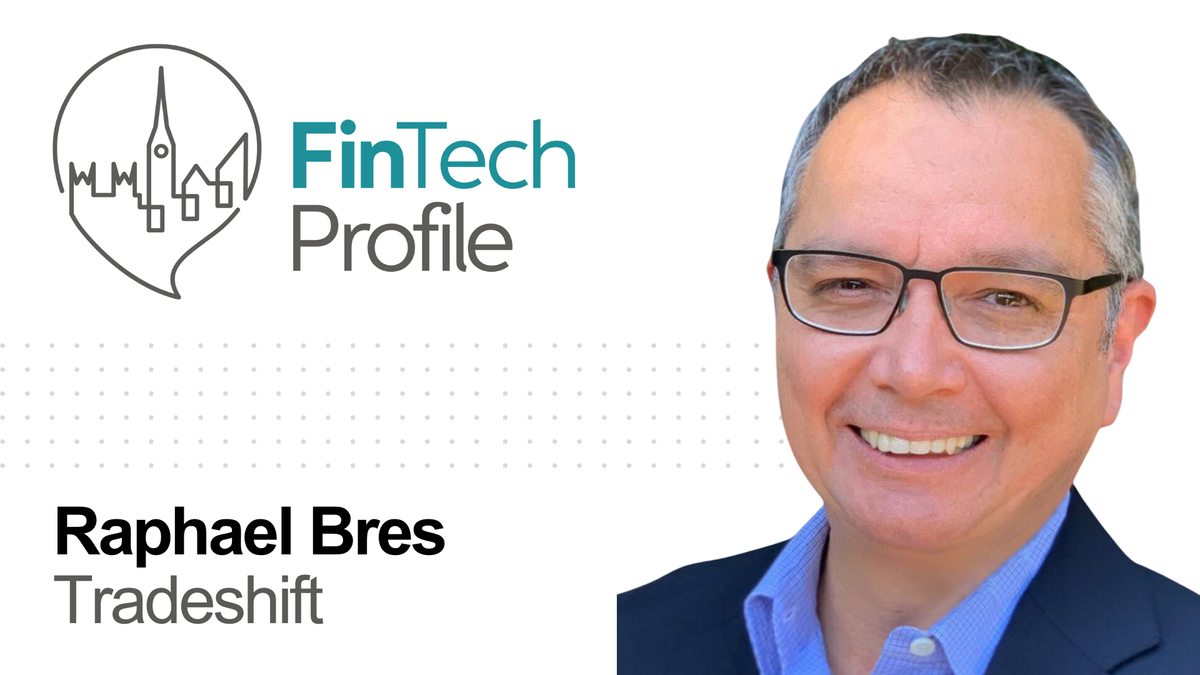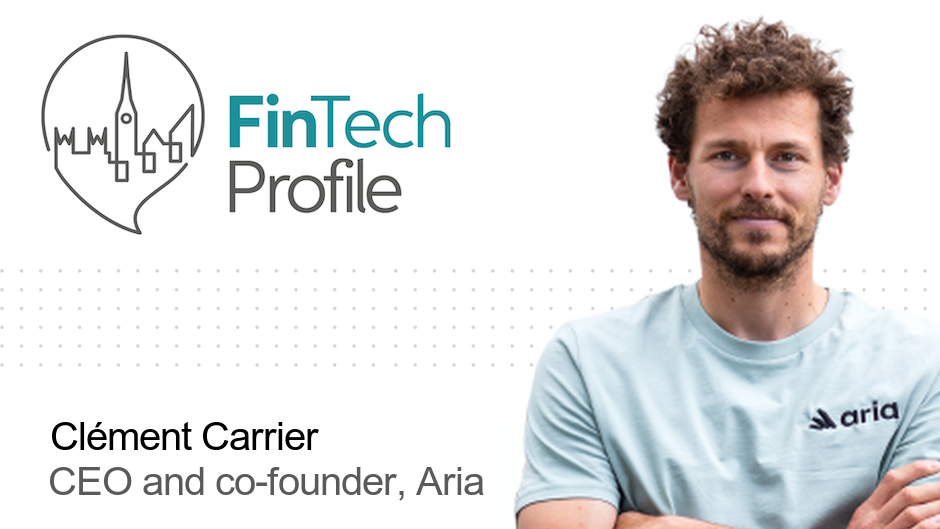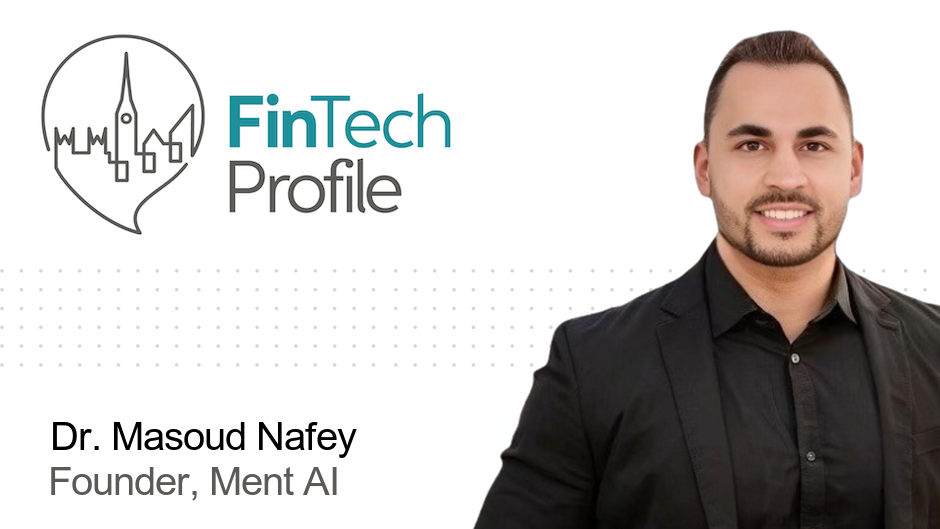Raphael Bres, Chief Product & Technology Officer, Tradeshift

Now, to the main event: Let’s meet Raphael Bres. Raphael is the Chief Product & Technology Officer of Tradeshift. You may be wondering why I’ve included the company here on FinTech Profile. At first glance, it’s easy to wonder where the ‘FinTech’ bit is.
You see, Tradeshift is a global B2B platform that helps businesses buy, sell, pay and get paid.
That quote of “every business is a FinTech business” comes to mind: You only have to scroll down Tradeshift’s homepage and you’ll see just how many financial services features they are offering, for obvious reasons. You can’t trade without financial services… the whole end-to-end supply chain consumes many, many FinTech services.
So there we go. Let’s learn more about Raphael — or Raphy — and his company.
Over to you Raphy:
Who are you and what’s your background?
I’m Raphael Bres, and I’m the Chief Product and Technology Officer at Tradeshift. Most people I work with know me as Raphy.
My background encompasses a blend of finance and information technology. I studied economics at university, did my first MSc in applied economics, and then another in Management of Information Systems.
I joined Deloitte in the mid-90s, just as digital was taking over the world. I was surprised to see how many of my colleagues were still taking a paper-and-pen approach to data analysis. I spent a lot of time teaching others the benefits of using technology to deliver in minutes the kind of insight that would otherwise take entire teams days to uncover.
Those early days at Deloitte set the stage for the rest of my career which has been heavily focused on using technology to transform inefficient business processes, harnessing huge swathes of data that in turn can be used to generate value and opportunity.
I’ve been privileged to play a role in driving enterprise digital transformation with some of the most well-known and successful innovators in this space, including Microsoft, Oracle and Workday.
Prior to rejoining Tradeshift, I spent two enjoyable years at sales commission software firm Spiff, where I was able to play a pivotal role in growing the business to the point where Salesforce decided to acquire the company.
What is your job title and what are your general responsibilities?
I’ve just rejoined Tradeshift as Chief Product & Technology Officer. Even after I left Tradeshift, I always kept a special place in my heart for the company, its vision and its mission. I’m absolutely thrilled to be back.
In my new role, I’m responsible for overseeing strategy, innovation and transformative technology initiatives across Tradeshift’s complete portfolio of solutions.
As a leader, it’s my job to inspire, guide and influence the team around me who will be responsible for executing our strategy. I’m a huge believer in the importance of creating an environment where people look forward to coming to work every day.
Right now, I’m particularly focused on how we apply AI and machine learning tools to the challenges businesses face with streamlining and automating processes, as well as creating new marketplaces where buyers and suppliers can connect with each other digitally.
Can you give us an overview of your business?
Tradeshift simplifies and automates complex business interactions such as purchasing, invoicing, and payments by providing a centralised digital platform where businesses can connect, collaborate, and transact efficiently and in full compliance with local tax rules.
We achieve this through a blend of payment automation, marketplace eCommerce, and embedded fintech services, providing businesses with tools to automate transactional processes, discover new suppliers, attract customers, and access the working capital they need to keep business flowing.
Our vision is to connect every company in the world, creating economic opportunity for all. At the core of this vision is the Tradeshift network. Today, Tradeshift is the world’s largest trade network, linking over a million companies globally, enabling seamless, digital transactions between customers and suppliers anywhere in the world.
Tell us how you are funded?
Tradeshift has a number of loyal investors, a number of whom have been with us since the very beginning of our journey. Some of our larger investors include HSBC, Koch Industries, LUN Partners and IDC Ventures.
Last August we announced a $70m funding round that included a mix of new and existing investors.
What’s the origin story? Why did you start the company? To solve what problems?
Tradeshift began life as an e-invoicing and accounts payable platform that digitises the exchange of purchasing and invoicing information between buyers and suppliers.
We embed automation and AI directly into the transaction process, eliminating huge swathes of manual work by increasing straight-through and touchless processing. Tradeshift customers have already seen AI reduce manual interventions by as much as 99.5%. This delivers huge efficiencies and cost savings.
But that’s just the beginning of our story.
Today we have over a million businesses active on the Tradeshift platform, all connected on a single, digital network. The network provides a ready-made environment for us to bring a huge array of additional value-adding services to every business that joins Tradeshift.
We actively encourage partners to build and innovate on that foundation. Last summer we announced our intention to form a Joint Venture with HSBC focused on the development of embedded finance solutions and financial services apps that will democratize access to working capital for businesses who would otherwise be left in the cold.
The activity we see on the Tradeshift platform provides us with genuinely unique insight into the pressures businesses face and how best to overcome them. These businesses and the relationships between them also represent the building blocks for a community of trusted traders. Our marketplace offering connects large organisations to pre-vetted suppliers in a curated purchasing environment that provides convenience, control and competitive pricing.
Tradeshift is a business that has virtually limitless potential, not just in terms of revenue, but also in terms of impact on society. The connectivity and tools we deliver through our platform go way beyond turning paper into bits and bytes, important as that is. It’s an opportunity to create a level playing field of access to global markets that will benefit businesses in every corner of the world.
Who are your target customers? What’s your revenue model?
We typically work with large enterprises and mid-sized businesses across various industries that have complex procurement, supply chain, and financial processes.
We have a particularly strong presence in sectors such as transport and logistics, manufacturing, FMCG, retail, and pharma & healthcare, with clients including DHL, Kuehne + Nagel, and the NHS.
Our solutions span finance and procurement and conversations with prospects will typically begin at the CFO and CPO level. Businesses that get the most from Tradeshift see us as an integral part of their wider digital transformation strategies.
The revenue model for our core e-invoicing and AP automation solution is SaaS-based, but we also have a variety of different models to suit different products such as embedded finance. The flexibility of our platform means the opportunities to innovate and bring new services to market are virtually limitless.
If you had a magic wand, what one thing would you change in the banking and/or FinTech sector?
I would love our sector to look at business challenges holistically. The pandemic revealed fundamental and longstanding problems with global trade, and it’s one we’ve been charting over the last few years with Tradeshift’s Quarterly Index of Global Health.
The supply chains that still dominate today are a relic of the 20th century and they’re no longer fit for purpose. Sticking plaster solutions are no remedy at all. What we need is a root-and-branch reimagining of how enterprises interact and trade with each other, and we must harness every technology at our disposal to do this. Too many B2B offerings today are focused on optimising individual aspects of accounting or invoicing, rather than looking at the opportunities of connecting businesses digitally – and everything that flows from that.
What is your message for the larger players in the Financial Services marketplace?
Join us! Tradeshift doesn’t pretend to have a monopoly on fintech innovation. What we do is select the best tech out there and work out a way to apply it in a holistic way. Our partnership with HSBC is just one example of how larger, established FS players can bring immense value to the new digital trading landscape, creating new opportunities for all.
Where do you get your Financial Services/FinTech industry news from?
When it comes to Fintech industries news, I use a combination of sources from industry specific websites such as Finextra and The Financial Brand, some general business publications such as Bloomberg, Forbes and Financial Times completed with Social Media and Professional networks such as LinkedIn and Twitter. From time to time, I check on Research reports produced by reputable firms like Deloitte and McKinsey.
Can you list 3 people you rate from the FinTech and/or Financial Services sector that we should be following on LinkedIn, and why?
I follow both B2C and B2B fintech thought leaders.
- On LinkedIn I follow Anne Boden because she frequently shares insights on Fintech trends and banking making Anne a valuable person to follow for anyone interested in the intersection of technology and financial services.
- I also follow Brett King who discusses, in conferences and podcasts, the future of finance including topics such as Artificial Intelligence, Machine Learning and Blockchain. His contributions are particularly valuable for those looking to understand the directions in which the financial services sector is heading.
- Finally, I follow Jim Marous who has a wealth of knowledge on digital transformation and innovation in the Banking industries.
What FinTech services (and/or apps) do you personally use?
As a US resident who originated from France, I have personal needs for cross-border payments at the best FX Rates.
I use Currencies Direct as my cross-border payments service. Currencies Direct provides an easy-to-use user interface, the ability to maintain wallets in different currencies, visibility on the process, real-time integration with my bank and more importantly access to interbank FX rates which are definitely better than Retail Bank FX Rates. I value the cost efficiency, the speed, the convenience and the very good customer service.
What’s the best new FinTech product or service you’ve seen recently?
One of the most promising technologies is Decentralised Finance (DeFi) for more financial inclusion to address individuals without accounts at any Financial service provider. In developing countries, up to 35% of economic activity occurs informally, equivalent to trillions of dollars. In under 5 years, DeFi has grown their user base expanding from less than 100K users in 2020 to over 40 million today! DeFi offers accounts, savings, loans, payment and investment using a combination of technologies such as Peer to Peer, Smart Contract and open source blockchain network. DeFi is open, transparent, censorship resistant and globally accessible via Smartphones and internet. Through the tokenization of assets, from cryptos to real-world assets like real estate, dividing into smaller, more affordable units, DeFi empowers individuals to invest and benefit from asset ownership which traditionally are out of reach due to high costs.
Finally, let’s talk predictions. What trends do you think are going to define the next few years in the FinTech sector?
If the first two decades of this century were all about the emergence of digital technologies, the next two will be defined by their application to decades-old supply chain models. The old paradigm of one-to-one relationships is being replaced by one-to-many and, through B2B marketplaces, many-to-many – all founded on the bedrock of digital technology.
Digital isn’t just a means to an end, though: it’s about doing things differently. For example, when businesses connect digitally, it opens up transformative opportunities in a range of fields: from unlocking trillions of dollars in supply chain finance, to providing participants with business-critical insight into the financial or operational health of their supply chains. Having shareable, real-time data will bring new opportunities for buyer-supplier collaboration – for example, on improving business processes and supply chains, or the introduction of new financial tools. Moreover, by breaking down siloes it will help businesses understand themselves better, improving communication and insight between departments.
We’re used to technology moving fast and breaking things, but changing ingrained processes habits and supply chain infrastructure will take years to accomplish.
It’s a task I look forward to with relish!
Thank you very much for taking the time to participate, Raphy!
If you’d like to connect with Raphael, find him on LinkedIn here: Raphael Bres.
I also encourage you to follow his advice and check out Tradeshift at www.tradeshift.com.




